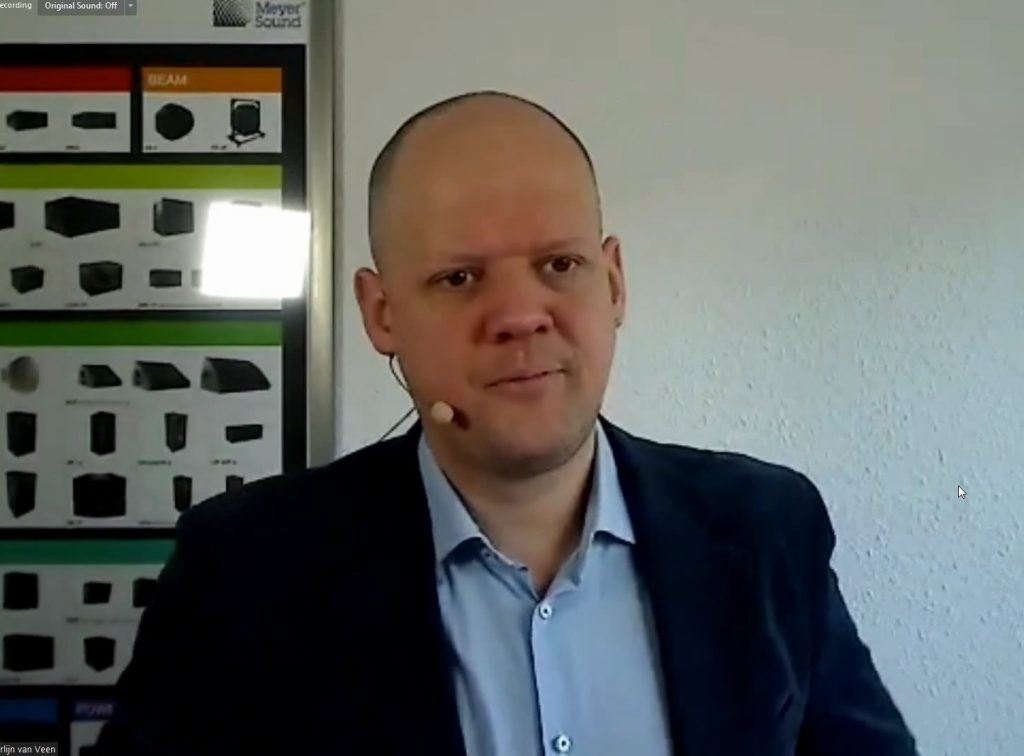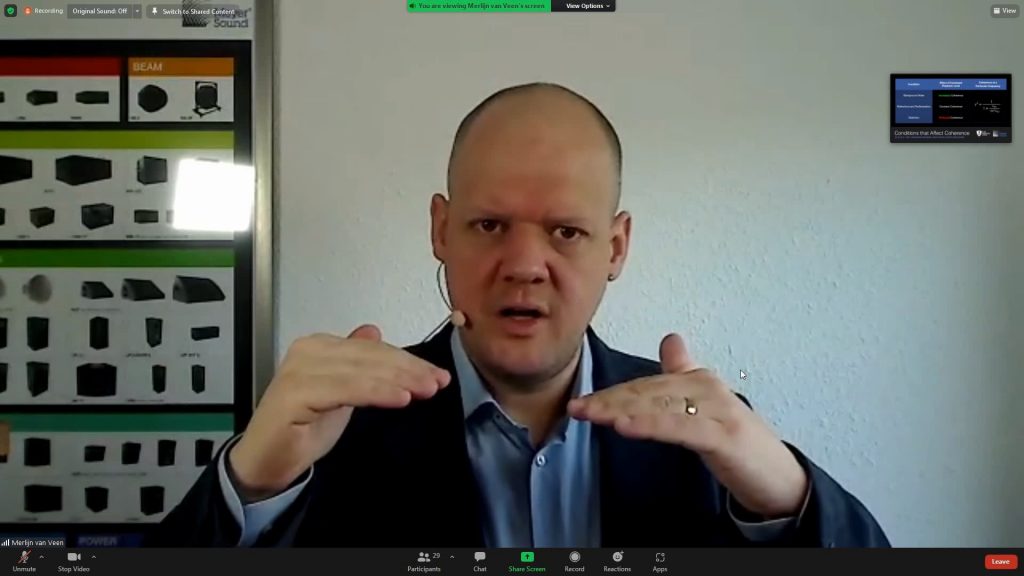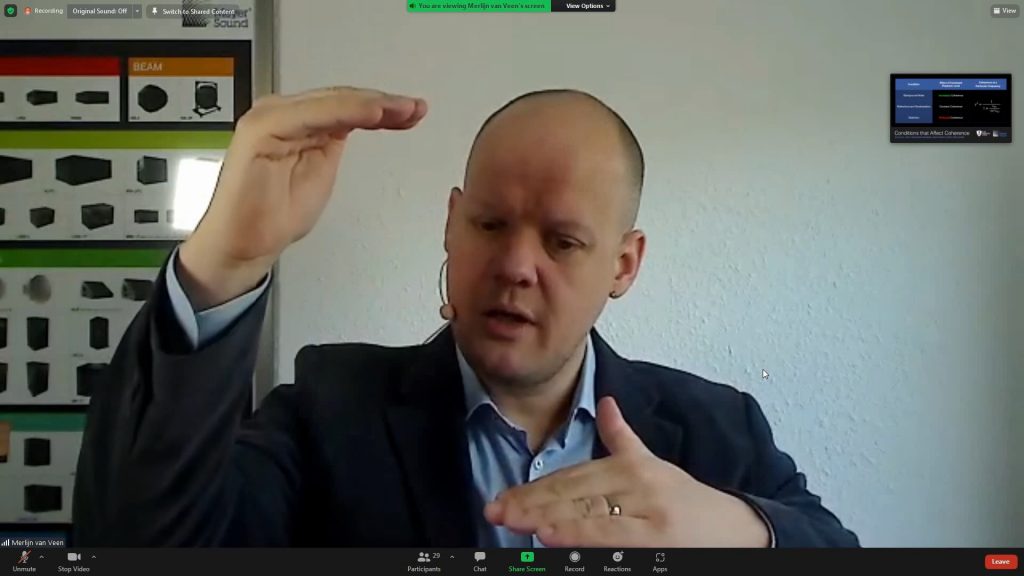On Monday February 14th the AES Melbourne Section turned to Zoom again for yet another online meeting.
Over thirty members and guests joined the meeting to hear Meyer Sound’s Merlijn Van Veen Chair of AES Task Group SC-04-03-A present on the current revision of the AES75 Standard “Measuring Loudspeaker Maximum Linear Sound Levels Using Noise”
After welcoming everyone, Section Chair Graeme Huon introduced Merlijn who started by explaining the work of the Standards workgroup tasked with developing this standard, noting that the Task Group consisted of more than 70 people from a wide range of related organizations who had met fortnightly for 2 years to thrash out this document. He went on to explain the genesis of the M-Noise signal within the Meyer Sound company, and its journey to consideration for inclusion in an AES Standard.

He explained that most other technological applications can quantify the proper specifications or operating parameters of devices and systems, citing examples of incandescent light bulbs and light switches/dimmers, commenting that the matching of audio amplifier settings and particular loudspeakers power handling capabilities come nowhere near that level of certainty. He commented that the weight of a loudspeaker box is easily quantified thus verifiable, and the goal of the revised AES75 standard was to achieve the same certainty in terms of its signal handling capability.
He went on to show how the commonly used pink noise signal does not correlate well to music in both spectrum and crest factor (peak to average ratio) indicating the need for a new test signal and methodology.
Using audio playback and visual graphing effects, he described crest factor and demonstrated the effect the varying of spectral content has on crest factor. He did this by adding high-pass and low-pass filtering with both pink noise and music signals, indicating the crest factor change in music but not in pink noise. He then used playback of pink noise and music tracks displayed via loudness analyzer software and applying bandpass filtering to demonstrate that the crest factor of music can increase significantly by varying the filtering applied, but the crest factor of pink noise stays constant regardless of filtering. He suggested that these results suggested a weakness in pink noise being used as a test signal analog for music.
Merlijn then posited that an ideal test signal to simulate music for loudspeaker output testing would be dense (as music is normally dense), mathematically derived, and have a crest factor and spectrum that is typical of music. He also suggested that it should be practical to use this new signal with Transfer Function analyzers designed to be used with pink noise.
He indicated that M-Noise was such a signal (explaining that M-Noise = “Music-Noise”) and went on to describe the initial publication of a SMPTE paper by Dr Roger Schwenke of Meyer in 2019 on the topic, which led to the AES Standards Group considering the potential use of this signal for a revamped AES75 Standard.
He then covered other Simulated Programme Content options indicating that although these may simulate the spectral content, their accuracy in simulation of the dynamic properties of music remain to be seen, showing favourable comparisons between M-Noise and some alternative signals.

He then introduced the concept of coherence (how much of the system output is correlated with the system input) and went on to cover an Institute of Acoustics paper (Schwenke & Van Veen) on determining the source of coherence reduction. He also provided examples of external noise sources interfering with the coherence result. He demonstrated how steady state acoustic noise like a vacuum cleaner, impulse noise like a hammer on an anvil, or simple room interaction effects can significantly impair coherence results. He explained that this indicates the need for an ample signal-to-noise and a high direct to reverberant ratio when making measurements. He remarked that this can be achieved by either increasing the playback level or optimizing the external conditions like background noise or reverberation.
Merlijn then described a conceptual test setup using these principles, displaying the steps taken, and then outlined the “stop” conditions of the test, the point at which at least one of the limits has been reached. He indicated those to be 2dB compression over at least two contiguous octaves, 3dB compression anywhere, or coherence <91% over at least one 1/3-octave anywhere.
He went on to describe the consensus building process needed for the 70+ members of the Task Group to arrive at a final outcome. He outlined the topics where consensus was needed, namely Derivation of the Test Signal, Use of Filtering, Finished Products vs Components/Transducers, Stop Conditions, Coherence, and Frequency Weighting.
Merlijn wrapped up his presentation with a look at the ripple effect of this development, with the M-Noise signal is being considered for expanded applications. He mentioned that SMPTE is evaluating it for use in assessing the performance of in-situ theatre and post-production installations.
He also cited AVIXA as being interested using M-Noise in validating end-to-end transmission quality throughout an entire signal chain in sound reinforcement and playback systems.
He went on to note that the Draft Standard has been published on the AES website, with the call for comments closing on February 21st.
Throughout Merlijn’s presentation as well as at the end, audience questions were accepted and responded to. The topics raised covered the range from the method of generating the signal, through the relationship between the level of decorrelation and the amount of distortion, the acceptable level of coherence

In answering a question about the duration of the test (the Draft Standard calls for 5 minutes), Merlijn indicated that this was a minimum duration, and revealed that Meyer Sound runs their tests for 2 hours on the basis that this is the duration of a typical feature film or music concert.
A question on the spectral content of the signal prompted a discussion of the shaping of the M-Noise signal with filtering in the low frequencies to match the device performance and application, but that the filtering used must be disclosed in the specification. – discussion followed on testing in the presence of background ambient noise and the steps necessary to minimize that. Following a question on using the test signal for performance measurements Merlijn demonstrated the measuring of the transfer function using various signals, like white, pink, Brown/red noise IEC61672 and M-Noise – for standard response measurements M-Noise will not reveal new information.
We thank Merlijn for his most interesting and informative presentation.
A video recording of the Zoom session has been created. An edited version is below:
This video can be viewed directly on YouTube at:
A PDF version of Merlijn’s slides is available at:
https://www.aesmelbourne.org.au/wp-content/media/AES-Feb2022.pdf
Related Links:
m-Noise website: https://m-noise.org/
M-Noise patent: on US PTO site
A New Signal for Measuring Loudspeaker Maximum Linear SPL (The original paper)
https://ieeexplore.ieee.org/document/9109546 (Login required)
YouTube video of paper presentation: https://youtu.be/k6xyzjjN08k
Determining the Source of Coherence Reduction Using Playback Level of M-Noise
https://www.ioa.org.uk/catalogue/paper/determining-source-coherence-reduction-using-playback-level-m-noise
Coherence as an Indicator of Distortion for Wide-Band Audio Signals such as M-Noise and Music
https://www.aes.org/e-lib/browse.cfm?elib=20582

